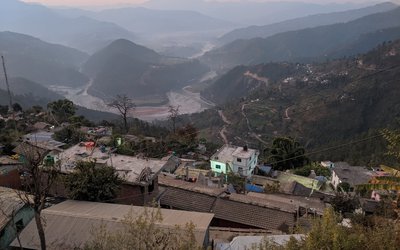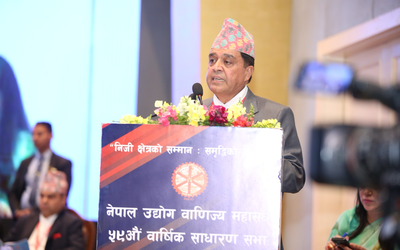
Following a massive second wave of COVID-19 in mid-2021, South Asia’s economy rebounded in the second half of the year.
The World Bank Outlook predicts that in Nepal, output is expected to expand by 3.9 percent in 2022 supported by better agricultural output and rebounding services activity on improving vaccine coverage. Bangladesh is expected to reach 6.4 percent in FY2021/22 ending June 2022, and 6.9
The economic damage brought about by the second wave in India has already been unwound, with output effectively returning to pre-pandemic levels. Contact-intensive sectors, like trade and hotels, however, are still below pre-pandemic levels. Growth in Pakistan surprised on the upside, supported by improving domestic demand, record-high remittance inflows, and a narrow targeting of lockdowns.
Growth in Bhutan has been revised down because of COVID-19 protocols, delays in infrastructure projects caused by migrant labor restrictions, and a stagnant tourism sector. An improvement in domestic demand and resumption of exports contributed to strong growth in Bangladesh. The return of tourists to Maldives supported an estimated 22.3 percent output expansion in 2021.
Consumer inflation in the major economies of the region has been above central banks’ targets since late 2019. In India, easing supply disruptions related to COVID-19 and deficient demand led to a return of inflation toward the central bank’s target in late 2021.
In Pakistan, high inflation led to the removal of monetary accommodation, while macroeconomic policies in Sri Lanka remained generally accommodative.
The Taliban’s takeover of Afghanistan in August led to a rapid cessation of international grants and financial support, as well as a loss of access to overseas assets and the international financial system. The country faces a humanitarian and economic crisis. Almost all of Afghanistan’s population is suffering from inadequate food consumption.
Growth prospects have improved since June 2021, largely because of better prospects in Bangladesh, India, and Pakistan. Regional growth is expected to accelerate to 7.6 percent in 2022 as pandemic-related disruptions fade, before slowing to 6.0 percent in 2023.
In most economies, monetary and fiscal policy are expected to remain broadly accommodative in 2022, but gradually shift to a focus on fiscal sustainability and anchoring inflation expectations.
Despite the upward revision to growth, output in 2023 is still projected to be almost 8 percent lower than projected before the pandemic. Additionally, the pace of per capita income catch-up with advanced economies is expected to slow over the forecast horizon.
India's economy is expected to grow by 8.3 percent in the fiscal year ending March 2022, unchanged from the June 2021 outlook. The forecast for FY2022/23 and FY2023/24 for India has been upgraded to 8.7 percent and 6.8 percent, respectively, reflecting higher investment from the private sector and in infrastructure, and dividends from ongoing reforms.
In the sub-region excluding India, growth momentum will pick up over the forecast horizon and is expected to expand by 4.4 percent in fiscal year 2021/22. Pakistan will benefit from structural reforms boosting export competitiveness and enhancing the financial viability of the power sector.
A rebound in investment and external demand is expected to lead to a 5.1 percent expansion in Bhutan in FY2021/22.
Global Growth to Slow through 2023
Following a strong rebound in 2021, the global economy is entering a pronounced slowdown amid fresh threats from COVID-19 variants and a rise in inflation, debt, and income inequality that could endanger the recovery in emerging and developing economies, according to the World Bank’s latest Global Economic Prospects report. Global growth is expected to decelerate markedly from 5.5 percent in 2021 to 4.1 percent in 2022 and 3.2 percent in 2023 as pent-up demand dissipates and as fiscal and monetary support is unwound across the world.
The rapid spread of the Omicron variant indicates that the pandemic will likely continue to disrupt economic activity in the near term. In addition, a notable deceleration in major economies—including the United States and China—will weigh on external demand in emerging and developing economies. At a time when governments in many developing economies lack the policy space to support activity if needed, new COVID-19 outbreaks, persistent supply-chain bottlenecks and inflationary pressures, and elevated financial vulnerabilities in large swaths of the world could increase the risk of a hard landing.
“The world economy is simultaneously facing COVID-19, inflation, and policy uncertainty, with government spending and monetary policies in uncharted territory. Rising inequality and security challenges are particularly harmful for developing countries,” said World Bank Group President David Malpass. “Putting more countries on a favorable growth path requires concerted international action and a comprehensive set of national policy responses.”
The slowdown will coincide with a widening divergence in growth rates between advanced economies and emerging and developing economies. Growth in advanced economies is expected to decline from 5 percent in 2021 to 3.8 percent in 2022 and 2.3 percent in 2023—a pace that, while moderating, will be sufficient to restore output and investment to their pre-pandemic trend in these economies. In emerging and developing economies, however, growth is expected to drop from 6.3 percent in 2021 to 4.6 percent in 2022 and 4.4 percent in 2023. By 2023, all advanced economies will have achieved a full output recovery; yet output in emerging and developing economies will remain 4 percent below its pre-pandemic trend. For many vulnerable economies, the setback is even larger: output of fragile and conflict-affected economies will be 7.5 percent below its pre-pandemic trend, and output of small island states will be 8.5 percent below.
Meanwhile, rising inflation—which hits low-income workers particularly hard—is constraining monetary policy. Globally and in advanced economies, inflation is running at the highest rates since 2008. In emerging market and developing economies, it has reached its highest rate since 2011. Many emerging and developing economies are withdrawing policy support to contain inflationary pressures—well before the recovery is complete.
The latest Global Economic Prospects report features analytical sections that provide fresh insights into three emerging obstacles to a durable recovery in developing economies. The first, on debt, compares the latest international initiative to tackle unsustainable debt in developing economies—the G20 Common Framework—with previous coordinated initiatives to facilitate debt relief. Noting that COVID-19 pushed total global debt to the highest level in half a century even as the creditors’ landscape became increasingly complex, it finds that future coordinated debt relief initiatives will face higher hurdles to success. Applying lessons from the past restructurings to the G20 Common Framework can increase its effectiveness and avoid the shortcomings faced by earlier initiatives.
“The choices policymakers make in the next few years will decide the course of the next decade,” said Mari Pangestu, the World Bank’s Managing Director for Development Policy and Partnerships. “The immediate priority should be to ensure that vaccines are deployed more widely and equitably so the pandemic can be brought under control. But tackling reversals in development progress such as rising inequality will require sustained support. In a time of high debt, global cooperation will be essential to help expand the financial resources of developing economies so they can achieve green, resilient, and inclusive development.”
The second analytical section examines the implications of boom-and-bust cycles of commodity prices for emerging market and developing economies, most of which are heavily dependent on commodity exports. It finds that these cycles were particularly intense in the past two years, when commodity prices collapsed with the arrival of COVID-19 and then surged, in some cases to all time-highs last year. Global macroeconomic developments and commodity supply factors will likely cause boom-bust cycles to continue in commodity markets. For many commodities, these cycles may be amplified by the forces of climate change and the energy transition away from fossil fuels. The analysis also shows that commodity-price booms since the 1970s have tended to be larger than busts, creating significant opportunities for stronger and more sustainable growth in commodity-exporting countries—if they employ disciplined policies during booms to take advantage of windfalls.
The third analytical section explores COVID-19’s impact on global inequality. It finds that the pandemic has raised global income inequality, partly reversing the decline that was achieved over the previous two decades. It has also increased inequality in many other spheres of human activity—in the availability of vaccines; in economic growth; in access to education and health care; and in the scale of job and income losses, which have been higher for women and low-skilled and informal workers. This trend has the potential to leave lasting scars: for example, losses to human capital caused by disruptions in education can spill over across generations.
- NEPAL-THAILAND: Joint Business Council
- Apr 13, 2025
- BIMSTEC SUMMIT: Nepal’s Stand
- Apr 11, 2025
- IME GROUP: Expands Into Paper Industry
- Mar 24, 2025
- CPN UML: Instigated By India
- Mar 23, 2025
- ADB’S CHIEF ECONOMIST: Nepal Reduces Poverty
- Mar 11, 2025















